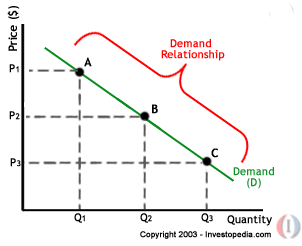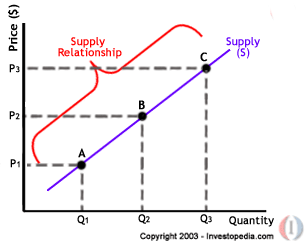Demand
Demand is how much a product is wanted by consumers. As explained previously in the post on price elasticity, the demand is oftentimes very dependent on the price of the product. Though sometimes it may be due to other reasons (popularity). The relationship between the demand and the price is called the demand relationship.
Below shows how a typical demand curve will look like. The gradient of the curve is always negative. The price is always on the y-axis and the quantity on the x-axis.

The law of demand is pretty simple and logical. The lower the price, the higher the demand and vice versa. As the price increases, the opportunity cost of buying the product also increases and therefore less people would buy the product. As shown in the graph above, point A has a very high price, but therefore the quantity sold is very low, compared to points B and C, where the prices are slightly lower but the demand is high.
Supply
The supply is how much the business/market can produce and supply to the consumers. The quantity of goods they supply are dependent on how much they are offered for the goods. Thus, the supply is once again dependent on the price as well...Seems like everything is dependent on the price.
The relationship between the price and the goods and services supplied is called the supply relationship.
The supply curve is the opposite of a demand curve, the gradient is positive.

The law of supply is also quite the opposite of the law of demand. The higher the price offered, the more the producers will supply. This is logical, as the higher the amount of money paid, the more you would want to produce and supply. The higher the money earned, the more profit these companies can make.
Works Cited
Investopedia.com. "Economics Basics: Supply and Demand." Investopedia – Educating the World about Finance. Investopedia.com, 2003. Web. 11 Dec. 2012. <http://www.investopedia.com/university/economics/economics3.asp>.
No comments:
Post a Comment